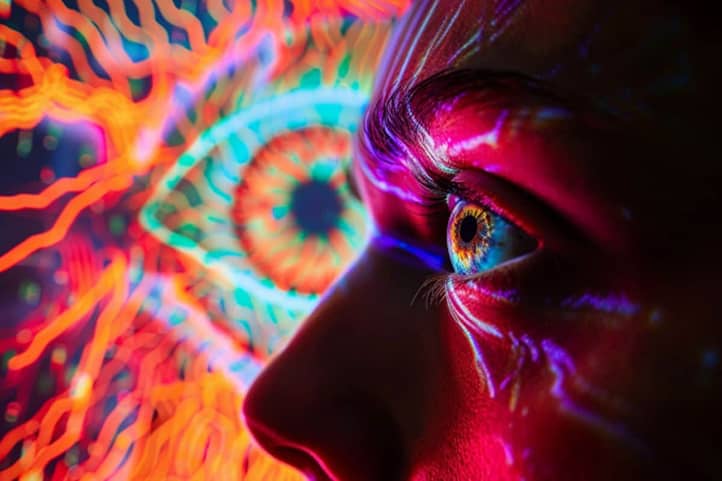Paranoia is a complex mental state that can significantly impact a person’s life and relationships with others. In this article, we’ll take an in-depth look at what paranoia is, its symptoms and causes, and explore methods of diagnosis and treatment.
What is Paranoia?
Paranoia is a mental state characterized by irrational and unfounded suspicions, distrust of others, and a conviction that people harbor ill intentions toward the individual. It goes beyond mere wariness or caution; paranoia can severely disrupt a person’s daily life, relationships, and ability to form social connections.
It’s important to note that paranoia can be a symptom of various mental disorders or a standalone condition. Either way, it is a serious issue that requires attention and professional help.

Symptoms of Paranoia
The human mind is a complex and multifaceted system capable of creating incredible worlds of fantasy and ideas. However, sometimes this ability can turn against us, distorting our perception of reality. Paranoia represents just such a case, where imagination and fears intertwine, forming an impenetrable veil of suspicion and distrust.
Like a shadow, paranoia follows a person, coloring each interaction and every situation in dark shades of assumed threat. It whispers in the ear, making one doubt even the most innocent gestures and words of others. This constant inner dialogue with an imagined enemy drains emotional and cognitive resources, leaving the person exhausted and isolated.
In a world where information and communication have become an integral part of daily life, paranoia finds new grounds to grow. Social media, instant messaging, and a continuous stream of news can intensify paranoid thoughts, providing endless material for interpretation and speculation. Every unread message or passing glance from a stranger can become a source of distressing suspicion.
Paranoia is not merely exaggerated caution or temporary distrust. It’s a deeply ingrained belief in the maliciousness of the surrounding world, which permeates all aspects of a person’s life. It alters reality perception, creating threats where there are none and fostering doubt even in the closest relationships. This state can become a prison for the mind, limiting life’s opportunities and joys.
Suspicion and Distrust
One of the key symptoms of paranoia is constant suspicion and distrust of others. A person with paranoia may:
- Constantly doubt the motives and intentions of others.
- Believe that they are being deceived or someone is attempting to deceive them.
- Interpret neutral or friendly actions as hostile.
- Be convinced that they are being watched or followed.
This suspicion often lacks real basis, yet for the paranoid person, it seems absolutely justified and logical.
Hypersensitivity to Criticism
People with paranoia are often extremely sensitive to any form of criticism or remarks directed at them. This can manifest as:
- Perceiving constructive criticism as a personal attack.
- Belief that others are constantly judging or criticizing them behind their back.
- Strong emotional reaction even to mild comments.
- Tendency to dwell on and worry about any criticism.
This hypersensitivity can make communication and interactions with others significantly more difficult.
Tendency to See Hidden Motives
A person with paranoia often tends to search for and find hidden motives in others’ actions. This may include:
- Belief that random events are actually carefully planned.
- Looking for “hidden meanings” in ordinary conversations and situations.
- Conviction that people are conspiring against them.
- Interpreting common coincidences as evidence of malicious schemes.
This tendency can lead to the creation of elaborate conspiracy theories that seem absolutely real and logical to the paranoid person.
Difficulties in Close Relationships
Paranoia can make building and maintaining close relationships extremely challenging. This can manifest as:
- Constant suspicion of a partner’s fidelity.
- Excessive jealousy and control.
- Difficulty trusting even close ones.
- Frequent conflicts due to suspicions and accusations.
These problems can lead to the breakdown of relationships and social isolation of the paranoid person.

Causes of Paranoia
The roots of paranoia run deep into a complex interplay of biological, psychological, and social factors. Like a tree growing in barren soil, paranoia can be the result of a combination of adverse life circumstances and internal predispositions. Understanding these causes is key to deciphering paranoid thinking.
In today’s world, where the boundaries between reality and virtual space are increasingly blurred, new triggers for paranoia appear. Social media algorithms that create information bubbles, and deepfake technology can intensify existing fears and create new ones. The constant feeling of surveillance, whether through CCTV cameras or digital footprints online, can serve as fertile ground for paranoid ideas.
Paranoia can also be a defense mechanism, a kind of shield that the psyche raises against perceived threats. Paranoid thinking can give an illusory sense of control and understanding of what is happening. Paradoxically, the fear of imagined threats may seem less frightening than acknowledging the chaos and unpredictability of real life.
Cultural context also plays a significant role in the formation and manifestation of paranoia. In societies dominated by an atmosphere of distrust, competition, or fear, paranoid tendencies can be reinforced and even encouraged. Political rhetoric, conspiracy theories, and sensationalist media messages can create a fertile ground for the growth of paranoid ideas, transforming them from an individual symptom into a social phenomenon.
Genetic Factors
Studies show that genetics may play a role in the development of paranoia:
- People with close relatives suffering from paranoia or other mental disorders have a higher risk of developing paranoia.
- Certain genetic variations may increase vulnerability to paranoia.
- Heredity can affect brain functions associated with paranoia.
However, it’s important to note that a genetic predisposition does not guarantee the development of paranoia.
Psychological Trauma
Traumatic experiences, especially in childhood, can contribute to the development of paranoia:
- Abuse or neglect in childhood.
- Serious betrayals or deceptions.
- Experiencing violence or threats.
- Traumatic events causing severe stress.
These traumas can form a deep distrust of the world and people, which can grow into paranoia.
Stress and Environment
Environmental factors and stress can play a significant role in the development of paranoia:
- Prolonged exposure to stressful situations.
- Social isolation or alienation.
- Living in an unsafe or hostile environment.
- Major life changes or losses.
These factors can create a fertile ground for developing paranoid thoughts and beliefs.
Use of Psychoactive Substances
The use of certain substances can trigger or exacerbate paranoia:
- Stimulants such as cocaine or amphetamines.
- Marijuana, especially in large doses.
- Hallucinogens.
- Alcohol, particularly with prolonged abuse.
These substances alter brain chemistry and perception of reality, potentially leading to paranoid thoughts and sensations.

Diagnosing Paranoia
Diagnosing paranoia is a complex process that requires a delicate balance between clinical expertise and empathy. Specialists face a paradoxical task: they must build a trusting relationship with someone whose primary condition is characterized by deep distrust. This situation demands a special approach, where every word and gesture can be crucial.
In the age of big data and artificial intelligence, new tools are emerging for diagnosing mental states, including paranoia. Analyzing a person’s digital footprint, their social media activity, and even smartphone usage patterns can provide valuable information for early diagnosis. However, these methods raise serious ethical issues around privacy and consent.
Cultural context also plays an important role in diagnosing paranoia. What is considered paranoid thinking in one culture may be the norm in another. Specialists need to consider the patient’s cultural, religious, and social background to avoid misdiagnosis and stigmatization. This requires a deep understanding of both clinical aspects and the broad spectrum of human experience.
Diagnosing paranoia is often complicated by the fact that patients actively hide their thoughts and feelings, fearing to confirm their worst suspicions of a conspiracy against them. This creates a kind of cat-and-mouse game between the specialist and the patient, where the truth is hidden behind layers of distrust and fear. A diagnostician’s professionalism lies in the ability to gently and gradually reveal the real picture without reinforcing paranoid beliefs.
Diagnostic Criteria
To diagnose paranoia, specialists use specific criteria:
- Persistent and unfounded distrust of others.
- Conviction of others’ malicious intent without sufficient grounds.
- Sustained paranoid thoughts and beliefs.
- Significant impact of these thoughts on daily life and functionality.
It is important to note that these symptoms must be present for an extended period and not be caused by other mental disorders or medical conditions.
Assessment Methods
Various methods are used to diagnose paranoia:
- Clinical interview. A detailed conversation with the patient to identify symptoms and their history.
- Psychological tests. Special questionnaires and tests that help assess the level of paranoid thoughts and beliefs.
- Behavioral observation. Evaluating the patient’s behavior in various situations.
- Information from close ones. Input from family and friends is often important, as a person with paranoia may not be fully aware of their condition.
- Medical examinations. To rule out physical causes of symptoms, such as brain tumors or neurodegenerative diseases.
Accurate diagnosis is crucial for determining the right approach to treatment.

Treatment of Paranoia
Treating paranoia is not just a medical procedure; it is a delicate art of restoring trust in the world and in people. It requires patience, a creative approach, and a deep understanding of each patient’s unique experiences. The therapist becomes a guide, helping the individual find a way out of the labyrinth of suspicions and fears toward a more open and trusting perception of reality.
Modern methods for treating paranoia increasingly turn to the potential of virtual and augmented reality technologies. These tools allow the creation of controlled environments where patients can safely explore their fears and learn new ways of interacting with the world. Virtual scenarios can be gradually intensified, helping patients step-by-step overcome their paranoid beliefs.
Group therapy for treating paranoia represents both a challenge and a unique opportunity. Bringing together people who suffer from similar fears and suspicions can create conditions for mutual support and learning. By observing others in the group overcoming their paranoid thoughts, patients may begin to question their own beliefs and open up to new perspectives.
A holistic approach to treating paranoia involves not only working with thoughts and emotions but also paying attention to the patient’s physical health, lifestyle, and social environment. Proper nutrition, exercise, relaxation techniques, and meditation play a significant role in reducing overall levels of stress and anxiety, which often accompany paranoia. Creating a supportive social environment and learning communication skills are also key elements of successful treatment.
Psychotherapy
Psychotherapy plays a crucial role in treating paranoia. The most effective approaches include:
- Cognitive Behavioral Therapy (CBT): Helps the patient identify and change unrealistic thoughts and beliefs. CBT may include:
- Identifying and testing paranoid thoughts.
- Learning skills to manage anxiety and stress.
- Developing more adaptive ways of thinking and behaving.
- Psychodynamic Therapy: Aims to understand the deep-seated causes of paranoia, often associated with past experiences and relationships.
- Group Therapy: Can help patients develop social skills and receive support from people with similar issues.
- Family Therapy: Important for improving relationships with loved ones and creating a supportive environment.
Medication
In some cases, medication may be necessary:
- Antipsychotic Drugs: Help reduce the intensity of paranoid thoughts and related symptoms.
- Antidepressants: Useful if paranoia is accompanied by depression or anxiety.
- Anxiolytics: Sometimes used for short-term anxiety relief associated with paranoia.
It is important to note that medication should be administered under strict medical supervision, as these drugs may have serious side effects.
Supportive Therapy
In addition to primary treatment, supportive therapy plays an important role:
- Stress Management: Relaxation techniques, meditation, and yoga help reduce overall stress levels.
- Healthy Lifestyle: Proper nutrition, regular physical exercise, and adequate sleep can improve overall well-being.
- Social Support: Participating in support groups or connecting with people with similar experiences is very beneficial.
- Social Skills Training: Helps improve interactions with others and reduce social anxiety.

Impact on Life
Paranoia constrains a person’s life, limiting their possibilities and distorting their perception of the world. It infiltrates all areas of existence, from daily routines to deep personal relationships, coloring each day with shades of suspicion and fear. This condition can turn ordinary situations into sources of stress and anxiety, forcing a person to stay constantly alert.
In the professional sphere, paranoia can become a significant obstacle to career growth and potential fulfillment. The constant expectation of being undermined by colleagues or management impedes effective collaboration and idea exchange. Creativity and innovative thinking often become casualties of paranoid thoughts, as the fear of being deceived or exploited suppresses the desire to share ideas and participate in collaborative projects.
Personal relationships, under the influence of paranoia, become a minefield of distrust and constant suspicion. Even the closest people may be seen as potential betrayers or manipulators. This creates a vicious cycle, where attempts by loved ones to offer support and help may be interpreted as hidden motives or part of a conspiracy. As a result, a person suffering from paranoia often ends up in social isolation, which only reinforces their fears and suspicions.
The impact of paranoia on quality of life is hard to overestimate. Constant tension and stress exhaust the emotional and physical resources of the body. Sleep disturbances, chronic fatigue and psychosomatic symptoms often accompany paranoid states. Life’s simple joys, spontaneity, and the ability to enjoy small moments gradually give way to constant vigilance and the expectation of the worst. This can lead to deep depression and a loss of purpose in life.
Social Consequences
Paranoia can severely disrupt a person’s social life:
- Isolation: A person may avoid social interactions out of fear or distrust of others.
- Conflicts: Constant suspicions can lead to frequent arguments and misunderstandings.
- Loss of Friendships: Friends may drift away due to the difficulties of communicating with a person suffering from paranoia.
- Difficulty Making New Acquaintances: Paranoia may interfere with establishing new social contacts.
Professional Difficulties
At work, paranoia may manifest as follows:
- Reduced Productivity: Constant suspicions and anxiety make it difficult to focus on tasks.
- Conflicts with Colleagues: Distrust and suspicion can create a tense atmosphere within the team.
- Career Growth Challenges: Paranoia hampers the establishment of necessary professional connections and relationships.
- Risk of Job Loss: In severe cases, paranoia may lead to job termination due to inappropriate behavior or conflicts.
Impact on Close Ones
Paranoia significantly affects family and close relationships:
- Emotional Strain: Loved ones may feel constant stress and tension.
- Trust Erosion: Paranoia can undermine the foundation of trust in relationships.
- Sense of Helplessness: Relatives often don’t know how to help or respond to paranoid thoughts.
- Risk of Relationship Breakdown: In severe cases, paranoia may lead to a breakup.
- Impact on Children: If one parent suffers from paranoia, it may negatively affect the psychological development of children.

Paranoia in Culture and Society
Paranoia, beyond individual experience, becomes a significant cultural phenomenon reflecting society’s collective fears and anxieties. In literature, cinema, and other forms of art, paranoid narratives often serve as metaphors to express social and political issues. They allow for the exploration of themes of power, control, and individual freedom in a world where the boundaries between reality and illusion gradually blur.
In the era of information technology and global communications, paranoia takes on new forms and dimensions. Conspiracy theories, spreading at lightning speed through social media, create parallel realities where millions of people can exist simultaneously. This phenomenon raises important questions about the nature of truth, trust in information sources, and the role of critical thinking in modern society.
Paranoia in culture often serves as a barometer of social tension and insecurity. In periods of economic crises, political upheavals, or global threats like pandemics or wars, paranoid sentiments in society intensify. This is reflected not only in art but also in daily life, influencing public discussions, political decisions, and interpersonal relationships.
Cultural interpretations of paranoia also play an essential role in the process of destigmatizing mental disorders. Artistic works that explore the experience of paranoia can promote better understanding and empathy for people suffering from this condition. They provide language and imagery to express complex emotional states, helping both patients and society at large better understand and discuss these issues.
Reflection in Art and Literature
Paranoia often becomes a theme in artistic works:
- Literature: Many writers have explored the theme of paranoia in their work. For example:
- 1984 by George Orwell, depicting a society of total control and suspicion.
- The Trial by Franz Kafka, reflecting a sense of helplessness against an incomprehensible and hostile system.
- Cinema: Films often use paranoia as a central plot element:
- A Beautiful Mind – a biographical film about mathematician John Nash, who suffered from paranoid schizophrenia.
- Rear Window by Alfred Hitchcock, where the protagonist suspects his neighbor of murder.
- Visual Art: Some artists, especially surrealists, reflected paranoid states in their work:
- Salvador Dali with his “paranoiac-critical method” of creating art.
- Music: The theme of paranoia appears in the lyrics of songs across various genres, from rock to hip-hop.
These works help society better understand and interpret the experience of people suffering from paranoia.
Social Stereotypes and Stigmatization
Unfortunately, many stereotypes and prejudices surround paranoia and other mental disorders:
- Danger Stereotype: People with paranoia are often seen as potentially dangerous, although in reality, they are more often victims than aggressors.
- Exaggeration of Symptoms: In popular culture, the symptoms of paranoia are often exaggerated or caricatured, which does not reflect reality.
- Stigmatization: People with paranoia may face social rejection and discrimination because of their condition.
- Misunderstanding: Many people do not understand that paranoia is a serious mental condition, not just “excessive suspicion.”
These stereotypes can complicate the lives of people with paranoia and hinder them from seeking help.

Conclusion
Paranoia is a complex and multifaceted phenomenon that deeply impacts the lives of individuals and society as a whole. This condition goes far beyond mere suspicion, forming a distorted picture of reality in which every action and word of others is perceived as a potential threat. Symptoms of paranoia, from constant distrust to hypersensitivity to criticism, can severely disrupt social connections, professional activities, and personal relationships.
The causes of paranoia are varied and often interconnected. Genetic factors, psychological trauma, stress, and environmental influences can all contribute to the development of paranoid thoughts and beliefs. In today’s world, where information technologies and social networks play a significant role in our lives, new factors emerge that potentially enhance paranoid tendencies. A constant flow of information, algorithms that create information bubbles, and the ability to interact anonymously online create a favorable environment for suspicion and fear to grow.
Diagnosis and treatment of paranoia require a comprehensive approach that combines professional assessment, psychotherapy, and, in some cases, medication. Modern therapeutic methods, including cognitive-behavioral therapy and group sessions, help patients reevaluate their beliefs and learn more adaptive ways of interacting with the world. Building a trusting relationship between the patient and therapist plays a crucial role in the treatment process, though this can be challenging given the nature of paranoid beliefs.
The impact of paranoia on an individual’s life is hard to overstate. Constant vigilance and fear drain emotional and physical resources, significantly lowering quality of life. However, it’s important to understand that with the right approach and support, people suffering from paranoia can learn to manage their symptoms and lead more fulfilling lives.
Paranoia as a cultural phenomenon finds reflection in art, literature, and cinema, often serving as a metaphor for broader social anxieties and fears. Studying paranoia in the cultural context helps to better understand not only individual experiences but also collective moods in society. At the same time, stigmatization and misunderstanding of paranoia remain serious issues that require attention and educational efforts.
Research prospects in the field of paranoia open new horizons for understanding this condition. Neurobiological studies, examination of genetic factors, and development of innovative therapeutic approaches, including the use of virtual reality, may lead to significant progress in the treatment and prevention of paranoia. Special attention is being given to the development of personalized treatment approaches that consider each patient’s unique characteristics.
In conclusion, I want to emphasize that, despite its complexity and severity, paranoia is treatable. Overcoming the stigma associated with mental disorders and creating a more inclusive society are key elements in this process.




